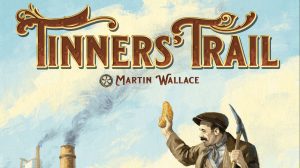There is a disorienting but exciting moment at the outset of every excursion into microgaming. I call it: looking at the cards and trying to guess what, exactly, is going on. Games created with so few component bits require creative and occasionally unorthodox designs.
The classic image, number, and text of the cards from Love Letter might hint at some sort of a last-card-standing skirmish. But in looking over the divided skulls, colors, and icons of Skulls of Sedlec, for example, can I somehow anticipate building a pleasing pyramid of exhumed skeletal remains?
My first glimpse of Dreams of Yesterday from designer Heather O’Neill and Weird Giraffe Games was a burst of colorful confusion. Okapis in orange, Triceratopses in turquoise, Mauve money, Golden goblets, and more with surrounding splashes of watercolor all over twenty-seven two-sided cards! Beth Sobel’s art certainly evokes a dream state of sorts.
But wait, isn’t this a post-apocalyptic museum game…of sorts? Sometimes you just have to dig in and play to have it all make sense. For now, let’s just say players are spending Resources to gather sets of Artifacts and we’ll see where it goes.
Which came first, the color or the commodity?
There are a few card types strewn about the deck. Resources are pictured in their color and their backgrounds fade from a central white to a surrounding watercolor splash. Knowledge (books) are green, Cash is purple, and Prestige (trophy) is yellow. Standard Artifacts are pictured in their color, but their backgrounds begin with the matching watercolor and fade to a surrounding white. Astonishing Antiquities are represented by the Orange Okapi; Bygone Bones by the turquoise Triceratops; and Cultural Curiosities by the Pink Portrait. These two card types come in single and double layouts.
Dreams of Yesterday takes place around a central rondel of cards, either five for a two-player game or seven with three players. One space is left open to indicate a player’s starting position. Each player begins with a Resource card bearing two resources and a single Standard Artifact card.

For each turn, a player may look one or two spaces clockwise around the rondel to claim a card. Resources are simply taken without cost. Artifacts must be paid for according to the cost depicted in the upper corner of the card. The player area consists of three rows of cards: the top row for Resources and two rows of exhibits below. Exhibits are horizontal chains of cards connecting the Artifacts. Each card is overlaid so that only the top card reveals its rightmost side, which is where an Artifact’s Ability is shown (more on that in just a moment).
Once a card has been claimed, the player then selects the top card from the deck and chooses which side to reveal, placing it into the empty space from which they began. In this way, the next player’s starting position in the rondel will always be slightly forward from the last.
If at any time a player cannot or does not wish to claim one of the two available cards, there are options. For a cost of one Resource, they may flip a card (remember both sides are cards in and of themselves) or move an additional space forward, or both. If still there are no good options, they may go to the deck, drawing cards until claiming a Resource, after which they take one of their original two options and move it to their starting space.

Each Artifact lends one of six Abilities to its owner. Each player can, at any time, have two active Abilities. Flip a card for free, move an extra space, rearrange a card from an exhibit, buy any card from the display, utilize an inherent resource (a free Book or the like), or make one resource into a wild. These abilities allow for fascinating combinations and sometimes make card placement rather agonizing.
There are two Rare Artifacts in the game. The first, Diverse Discoveries, are crates that serve as wilds in set collection. Not only are they wild, they help the cards placed both before and after in the exhibit. If placed between a Triceratops and a Portrait, then, a crate would count once for each set.
The second, Unusual Urns, are shuffled in with the discard pile the first time the deck runs out. The monochromatic urns provide endgame bonuses based on the sets. These are highly lucrative, but once claimed and placed they seal their row, forbidding the addition of further cards. A player sealing two exhibits serves as one of the endgame triggers. The second trigger comes If ever the rondel cannot be replenished because there aren’t enough cards to keep a deck going.
In scoring, players first allot points based on the number of connected Artifacts in both exhibit rows. More Artifacts equal more points. Next, each Unusual Urn yields its bonuses and the player with the most points is deemed the post apocalyptic museum curator whose exhibits will most likely change the world.
Come again?
I absolutely love Beth Sobel’s artwork and the alliterative color choices throughout Dreams of Yesterday. The nature of the Artifacts definitely suggests a museum, but the post apocalyptic thing is lost in the shuffle. Honestly, it’s no hindrance to the game.
I was genuinely confused at my first view of the cards. There are splashes of color everywhere and each card plays the role of two, so it was all jarring. But within a few turns, everything clicked into place and the cards made perfect sense. Normally I wouldn’t describe the cards with as much detail as I did above, but the design is indisputably intentional and it reads beautifully once the mechanisms are mentally in place. Even the Ability icons are intuitive and the rulesheet was unnecessary midway through the first play.
The rondel is smooth but restless: flipping, drawing, placing, and shuffling take time—the consequence of a small deck with no wasted space. Microgames earn a bit of a pass on matters like this. The thrill is in the economy of it all.
The Abilities are perennially useful, and certain situations will benefit from specific Abilities, making card placement decisions interesting. For example, drawing the Okapi might be a no-brainer, but would you rather be able to flip a card or move an extra space in the rondel? Is it worthwhile to cut off the run of Portraits just to get that Triceratops and an evergreen book Resource? Fun little moments like this season the whole experience.
Unusual Urns, similarly, provide a decent tension. First, there is the decision of when and how to lay them into the rondel. You could bury them facedown in an attempt to distract other players from your intention to later flip and claim the bonus. You could put one out early to tempt an opponent to cut off a row before the bonus disappears. Once in the rondel, you must decide when to claim the Urns, knowing they move the game towards an end and halt one avenue of scoring. It’s all quite lovely.

Speaking of that second endgame trigger: when the discard is down to only a few cards, yet another tension enters the fold as players may try—or try not—to lend the game a bit more time by purchasing and keeping the restocked discard alive. When an opponent is sitting on a stash of resources, it might be time to deplete the deck and end it before they strike.
Coincidental conclusion
This may sound strange, but our favorite way to play has been…the wrong way. In both design and mechanics, Dreams of Tomorrow presents a tight economy with a struggle to collect the right resources and to time purchases well. We mistakenly played our first two games (two players) with all the cards. By not removing the prescribed five, we found the economy a bit more wide open and the results rather satisfying. Five cards and five extra minutes go a long way to creating a playground for maximization.
By removing cards for the two-player game, or playing with the full deck and three players, we definitely felt constricted, which I’m certain is by design. Most often, the slimmer setup meant playing a single exhibit row rather than two, and struggling to accumulate the means to chase the Diverse Discoveries (crates) or the Unusual Urns.
Regardless of the ruleset, though, we preferred two players to three. The larger rondel for three made the deck management and exchanges tighter yet and no one even tried a second exhibit row. The games ended almost exclusively by deck exhaustion before folks could gain any real traction on the Urns. I’m guessing this would even out over time as players learn the opportune moment (and I think it’s much earlier than is intuitive) to close off the exhibits. The addition of a second deck could easily push the player count and maintain opportunities, but I’d keep the base game a duel otherwise, and experiment with removing a card or two less if you’re interested in opening it up.
There is a solo mode included that involves a conditional list for the Robot player. If the Robot currently has A, claim B, otherwise C and so on. I am not typically a solo gamer, so I did not spend time with the solitaire ruleset.
Dreams of Tomorrow is on Backerkit now. I’m not sure if the design team has any revelations in store for the campaign, but they’re off to a solid start. With an offbeat look on the table and a smooth set of mechanics, Weird Giraffe has a quirky-fun entry in the microgaming category.











Add Comment